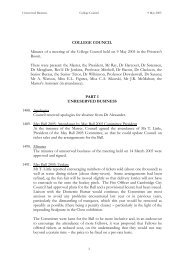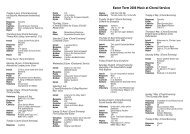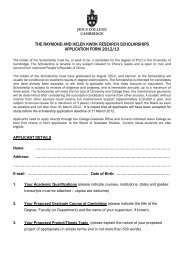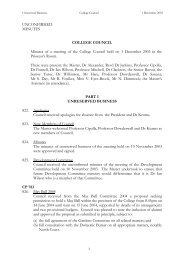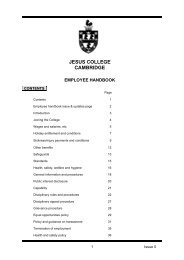2012 Annual Report - Jesus College - University of Cambridge
2012 Annual Report - Jesus College - University of Cambridge
2012 Annual Report - Jesus College - University of Cambridge
Create successful ePaper yourself
Turn your PDF publications into a flip-book with our unique Google optimized e-Paper software.
The Unreasonable Effectiveness <strong>of</strong><br />
(Basic Secondary School) Mathematics<br />
Dominic Orchard, <strong>Jesus</strong> Graduate Student<br />
EXPLANATIONS I <strong>Jesus</strong> <strong>College</strong> <strong>Annual</strong> <strong>Report</strong> <strong>2012</strong> 27<br />
They claim it was Einstein, it may have been<br />
Feynman, but whoever said “if you can’t explain it<br />
simply you don’t understand it well enough” really laid<br />
down the gauntlet for us theoreticians. Whilst<br />
sometimes excruciating, I have found that this<br />
process <strong>of</strong> simplifying and explaining greatly benefits<br />
my understanding <strong>of</strong> my own work and its place<br />
within the wider research context. This April I had the<br />
fantastic opportunity to once again put myself<br />
through this process at the 5th annual <strong>Jesus</strong> <strong>College</strong><br />
Graduate Conference.<br />
Primarily, my research concerns the design <strong>of</strong> programming languages for creating reliable<br />
and efficient s<strong>of</strong>tware. In contrast with natural languages, such as English, Latin, etc.,<br />
programming languages are highly constrained and contain much less ambiguity. They<br />
allow programmers to define complex calculations and manipulations <strong>of</strong> data which are<br />
then translated into more simple, prosaic instructions understood by computer hardware.<br />
A significant aspect <strong>of</strong> my research consists <strong>of</strong> defining the semantics <strong>of</strong> programming<br />
languages using abstract mathematics. A formal and precise semantics allows<br />
programmers to more accurately reason about the correctness <strong>of</strong> their programs, which is<br />
especially important in safety-critical systems, such as medical devices and transport.<br />
Faced with just fifteen minutes <strong>of</strong> air-time I wondered how I could explain any part <strong>of</strong><br />
my fairly theoretical research in programming languages. How could I provide any<br />
intuition about what any <strong>of</strong> it means, particularly the mathematics? Fortuitously, many<br />
concepts in mathematics have the remarkable habit <strong>of</strong> appearing frequently in a variety <strong>of</strong><br />
different contexts. Even more fortuitously for me, the underlying mathematical concepts<br />
<strong>of</strong> my research appear in a dizzyingly large number <strong>of</strong> areas, not least <strong>of</strong> which is in basic<br />
mathematics. The concept is remarkably simple and unknowingly embedded in the minds<br />
<strong>of</strong> most people with even basic arithmetic knowledge, yet it underpins a vast number <strong>of</strong><br />
topics in mathematics, logic, philosophy, physics, and computer science.<br />
Consider the following simple sums:<br />
2 + 2 = 4 3 + 0 = 3 0 + 7 = 7 0 + 0 = 0<br />
The last three have a common form: x + 0 = x or 0 + x = x. These are two simple axioms <strong>of</strong><br />
integer arithmetic, where a variable x acts as a place-holder meaning “any number”.<br />
Consider now the following sum <strong>of</strong> three numbers:<br />
3 + 4 + 2 = 9<br />
The result can be calculated by adding together one pair <strong>of</strong> numbers at a time, in two<br />
different ways:<br />
(3 + 4) + 2 = 7 + 2 = 9<br />
3 + (4 + 2) = 3 + 6 = 9<br />
where parentheses delimit addition <strong>of</strong> two numbers. Clearly it is irrelevant which pair <strong>of</strong><br />
integers is added first; the final result is the same. This behaviour can be generalised as the<br />
axiom: (x + y) + z = x + (y + z).






